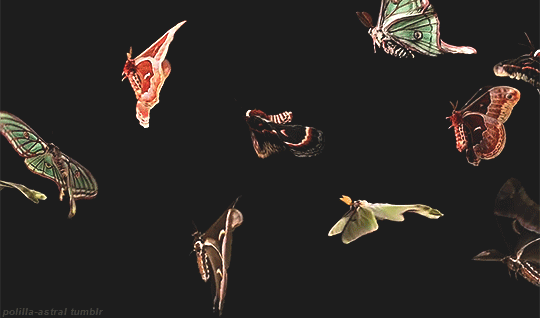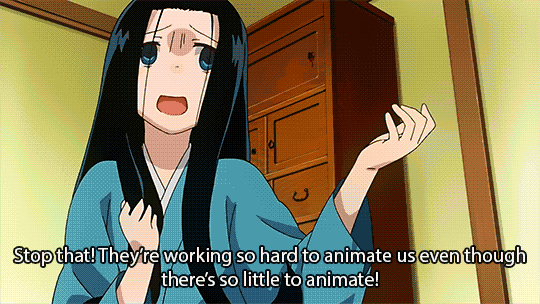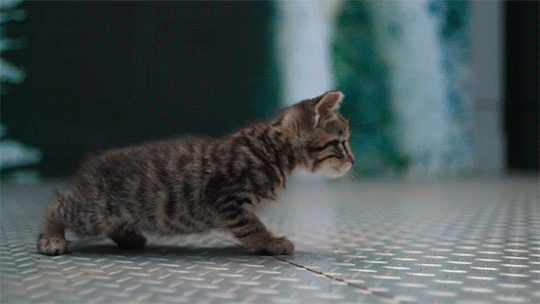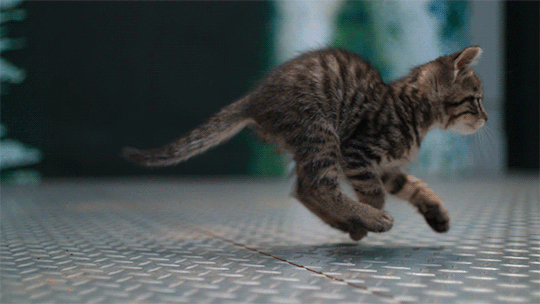Photo
Watching gifs like these are a good way to study animation, and shots like these have a good variety of motions to look for! In the first gif, have a good look at how much motion there is in different sections of Judy's body - the root of her body is helping to emphasize the accents of the motion. There is a good sense of secondary motion in the ears as well - note how they stay generally stiff near the base of the ear, but have more motion and softness near the tips, giving the ears a sense of structure and support. Also note how little Nick is moving in the foreground - Judy is the focus of the shot, and while there needs to be enough motion to keep him looking completely locked and dead, there shouldn't be so much motion that it detracts from her, and her dialogue. Similarly, in the second gif it's Judy who is barely moving, allowing the viewer to focus on Nick and his acting. Note the half-blinks that indicate some change in eye direction and in thought process. There is a lot of fun motion happening in Nick's motion, from the uncurling of the screen right hand to the overlap on the screen left hand as it rests against the stroller handle, but what I find most interesting of the motions is how the eyebrows move before the rest of the body. It's a nice anticipation of moving upwards before the body moves downwards, and it helps give enough time for the viewer to register the change in emotion before the relatively large body motion. The third gif is good for a lot of motion and acting analysis, but something to note is the lip sync. Notice the phrasing and choice of phonemes - not every letter is spelled out evenly. For "Felony Tax Evasion", the jaw only drops three times, which lets the rest of the syllables blend together smoothly. The words are still clearly readable even in this gif without sound, which makes it an excellent source of analysis. Also worth watching is how there are subtle motions in the cheeks and nose that are being influenced by those large jaw motions. By tying in other parts of the face into the mouth motion, it helps the face look fleshy and organic. In the third gif, there is a lot being said by Nick's stillness. While there is slight motion on the body to have him sag, most of the motion is on how wide his eyes get - this is the important storytelling moment, where he realizes he underestimated the damage she could do to him. Also worth watching is Judy - she stays very still while he's opening his eyes wide, and once SHE has a moment for his alarm to register, she begins moving to open up her file. It's a wide, slow arc, indicating a relaxed motion. She knows she has his attention, and is now playing up the moment by being very casual about the power she has over him. All in all, a great set of gifs with lots of potential analysis in both motion and thought process!




Zootopia (2016)
4K notes
·
View notes
Video
youtube
Second sequence i am posting here, I had the pleasure to work at SPA on the Netflix movie Klaus directed by Sergio Pablos to animate mostly the character of Jesper. Here is one of the few animations i have done for the movie!





2K notes
·
View notes
Video
...S to C curves.
tumblr
#s to c curves#video#lizard#newt#honestly not sure what this bad boy is except that he's got the moves
184K notes
·
View notes
Photo
A great example of S to C curves as overlapping action!
As the dog turns its head to the left, most of the fur around its head is still dragging towards the right - it’s only when the head stops moving that the fur catches up, but by the time it’s caught up, the dog’s head is already rotating to the right, which makes the fur drag again.
In this case, you can see how the fur motion ripples down through the body - this LOOKS like the fur is influencing the fur, but remember that there’s a body under all that fluff! What is actually happening is that the head is moving so much that it’s causing the body to twist as a REACTION to the head twist. The fur on the body is twisting because of the body, and the body is twisting because of the head. You can see how much the body is moving by watching the paws - at several points through the shake, the front feet shift and slide because of how much the body is moving!
tldr: this is a very complicated series of motions in the head and body that are resulting in a wave formation of fur.
more important tldr: dog :)

The fluffiest vortex
32K notes
·
View notes
Photo
Step by step process! Animation, then inking, then colouring!

2K notes
·
View notes
Photo
Slow motion flight of moths!
You can really see the S to C curves on some of these, particularly the yellow-green one near the bottom right/center - the front edge of the wing moves first, and drags the rest of the wing membrane with it. This is especially clear on the end tips of the wings that only respond to the overlapping motion of the rest of the wing!

♠
194K notes
·
View notes
Photo




Some personal animations in TVPaint
2K notes
·
View notes
Text
attended junji ito’s artist talk today and his literal advice to all artists/cartoonists can be summed up with “go to fucking sleep”
36K notes
·
View notes
Text



Hey y’all this is just a reminder that you can do smears in 3D animation too!
Check it out - they managed to go for all three varieties of smear! There are two hands, creating a multiple-pose effect on one frame. One of the hands(the upper) is HEAVILY distorted, way wider than it should be and also broken at the wrist, taking up more space than a normal hand to help guide the eye through the motion. And then they’ve got some graphic motion lines juuuuuust in case the other two options weren’t doing the trick.
ANIMATION
one of my fav scenes in into the spider verse is the one where miles just bonks a dude in the face with a bagel and knocks him over like -




fucking superb you funky little spider boy
48K notes
·
View notes
Photo

The biggest trick to remember when working on the bouncing ball assignment is to remember it’s not just about the “vertical spacing”. BUT also about the “horizontal”. If you ignore this you’ll find your animation will ‘stall’ at the top of the arc…and then ‘pop’ forward as it falls. This is not what actually happens.
The trick is to have the bouncing ball ease in to the top of the arc VERTICALLY but the HORIZONTAL either decelerates, accelerates or is constant.
1K notes
·
View notes
Link
Everything is a bouncing ball!
The basics are important not just because it’s a good introduction to the elements of animation, but also because they’re constantly in use! These elements are crucial in communicating clear, appealing, and realistic animation!
166 notes
·
View notes
Photo

I’m going back to traditional animation after a one year break, not that easy.
Design by Yann De Preval from the Character Design Challenge
10K notes
·
View notes
Photo
An EXCELLENT animation joke here! Please note that all of this has been animated on 1's(which is to say that each drawing is only being held for 1 frame), where most anime is animated on 3's(each drawing held for 3 frames). This makes the animation look especially fluid, but is extremely time consuming to do - even classic Disney cartoons tended to animate on 2's as much as possible! Also worth noting is the beautiful flow of S to C curves in the long hair - this is another thin that is often heavily simplified in anime. What's more, the entire shot is complicating the animation - the low angle with multiple head turns, the way the hand interacts with the hair, and the extreme foreshortening of the hand as it moves towards the camera. Lovely animation combined with a wonderful awareness of the skills and pitfalls of the industry! (This clip is sourced from an anime called Joshiraku, and the rest of it appears to be animated in a more traditional anime style)

123K notes
·
View notes
Text
some resources for people who want to start animating
free animation programs
the 12 principles of animation
51 animation exercises (from beginner to expert)
glen keane animates a scene
my advice: have fun and play–play is learning | always be watching real life to see how things move | also be watching cool animations to learn from them | don’t wait until you’re ‘good at art’–animating will help you improve | it’s hard but so worth it when things turn out well, good luck!
65K notes
·
View notes
Video
STUDY TIME! For reference, the stumble happens about 6 seconds into the video, in case you want to quickly watch.
This is a quick action, but it shows a lot about weight and balance, and why sometimes a motion cannot be stopped, so let's have a look!

This is the defining moment, where things start to go wrong! The paw is over the edge of the drop, and the toes are spread in order to start distributing the weight. You can see clearly in the reflection in the water that there is no part of the paw that is on the ground at all - the body is preparing to shift the weight, but there’s nothing there to support it!

Just a fraction of a second(5 frames later), and you get the “OH SHIT” moment from the lion - the toes are still dropping in an attempt to find something to put that weight on, but again, as you can see in the reflection, there is no hope. The lion’s tail is starting to whip out to the left to windmill - cats’ tails are primarily used for balance, and it’s one of the quickest things to react to the sudden change.
What isn’t quite so clear is that the back foot is actually off the ground - in order to try to get a better stance and regain balance, the back feet hop forward, relying on the front left paw to hold the weight for just a moment. Watch the 6-8 second segment a few times to watch that paw!

Three frames later, several things are happening! The tail is continuing to windmill upwards - at any point, if that tail were to hit something, it would give the lion a bit of leverage to get itself back to the left, hopefully stopping the fall. The back right foot has planted as far to the right as it can manage - you can even see one toe curled over the corner! The goal here is to get the foot as far to the right as possible, so that there’s leverage to push back towards the left. Unfortunately, there’s mo more room to work with, and the small amount of distance that the foot moves isn’t enough to fight the forwards/sideways momentum that’s already built up.
An interesting thing to note here is the back LEFT paw - from this point, and for another moment or two, it’s in the air, doing a little waggle! This is another balance saving technique, and I invite you to try this yourselves - stand up, and lean as far to the right as you can with both feet on the ground. When you bring your left foot up and to the left(pivoting the leg from the hip), you’ll find that you can bend farther. What this means for balance is that if you were forced suddenly to lean right, you have a better chance of distributing that weight if you have one foot as a counterbalance. That’s essentially what this lion is doing!

Four frames later, and disaster is imminent. I’m including the reflection to show just how much of the lion’s body is overlapping the edge of the barrier - that’s a lot of mass that’s not being supported by the ground!
It’s hard to tell with the motion blur(that tail is moving very fast), but the tail is now rotated to the right - again, it’s trying to find something to catch and balance from, in the same way that when humans windmill with their arms, we’re looking for something to grab and push off from!
The feet are what’s interesting at this point - you can still see that the back left foot is still lifted(still mid-waggle), and that the back right foot is still planted.
What’s interesting is what the front feet are doing!
The front left paw is starting to lift up off the ground - if you look carefully, you can see the paw-pads of the toes. It’s hard to tell from this angle, but the reason for this is that the lion is too far forward! If he hadn’t stumbled, this would have been the part in the walk where that foot would have lifted in order to start taking another step forward. Even though he’s stumbling, there’s just no way to do anything other than step forward - the anatomy of the leg and shoulder have reached their limits!
For similar reasons, the front right foot has started to move back towards the concrete. In no way will this help the lion regain its balance, but because the left foot has to lift up at this point, there has to be something there to take the weight, or he’s going to do a faceplant.

Unfortunately, that step forward is the motion that makes this impossible to recover from. Too much of the lion’s weight has shifted to the right side, where there is no support. The tail has completed a full rotation and is now pointed back down where it started less than a second ago. Now the head, shoulders and a good portion of the mid-section are over the edge - even though the back left foot is still lifted, there’s not enough weight in that leg to counterbalance that much mass.

So the lion does the only thing that the lion can do - lean into it, and try to make it a controlled landing! The entire body has started to turn in a diagonal angle towards the water, where before this it was resisting and trying to stay parallel to it.
The left rear paw has planted, and you can see that it’s now turned towards the water. It now has the stability to help control the action and prevent it from being as ungraceful as the rest of the motion was!
The right front paw is starting to move off the concrete edge - it’s blurry in this screenshot, but watch the video play a few times, and you’ll see how the leg is starting to move in order to stretch out.

Both front legs are fully extended to try to “land” in the water, while the back legs stay on the concrete to try to hold back the weight and make the landing less heavy.
The poor tail is still windmilling in an attempt to find anything at all for support. It will find nothing.

SPLORSH

WHY BROTHER
tumblr
djfjdjkdjk
218K notes
·
View notes
Photo
Fantastic reference here!
In the first GIF, look at how low the body and haunches drop as an anticipation to the action - from a more mechanical sense, this helps the legs to bunch up so that there’s more pushing power from the muscles on the full extension!
In the second and third GIFs, notice how the paw rolls up off the ground - it moves from being flat and solidly planted up onto the toes, with that pushing power being active right up until the body moves high enough that the foot can no longer be in contact with the ground.
In the last GIF, watch how the feet make contact with the floor starting with the toes - particularly in the back foot, you can see the pressure moving up the foot as the weight comes down.
Also, compare the first and third GIFs in terms of the squash/stretch in the body - there’s a HUGE amount of extension as the kitten pushes off the ground for the first time in the first GIF, but by the time the back legs are coming so far forward in the third GIF, the length of the body has crunched into HALF the length that it was in the first!
Thank you @stitchplz for sending this post along!




[x]
55K notes
·
View notes
Video
A great example of when weight isn't properly placed - keep a close eye on where their front feet are when they land, and why those placements do/don't work. Also, some great examples of overlapping action on those ears!
tumblr
From @huskyranch: “The stairs are so tough…” #cutepetclub [source: http://ift.tt/2zhSb1B ]
650 notes
·
View notes